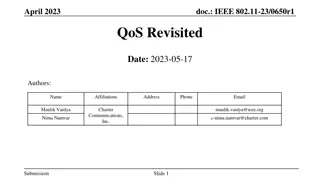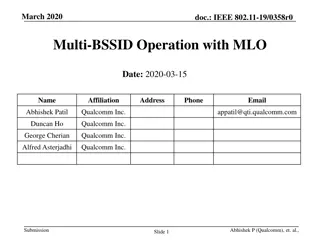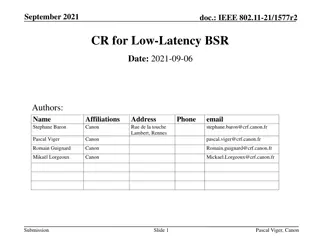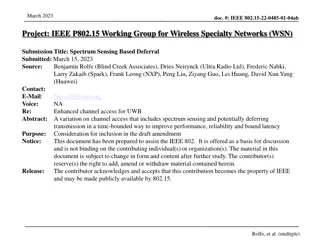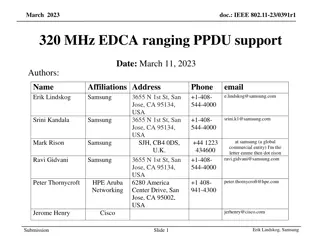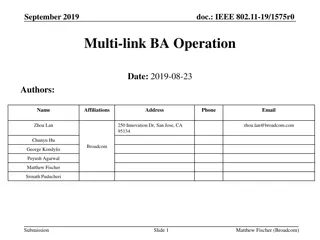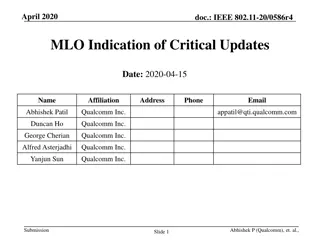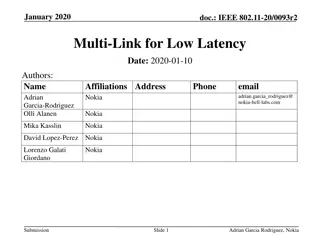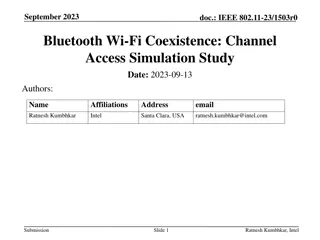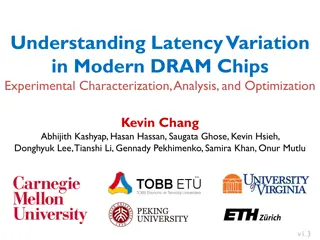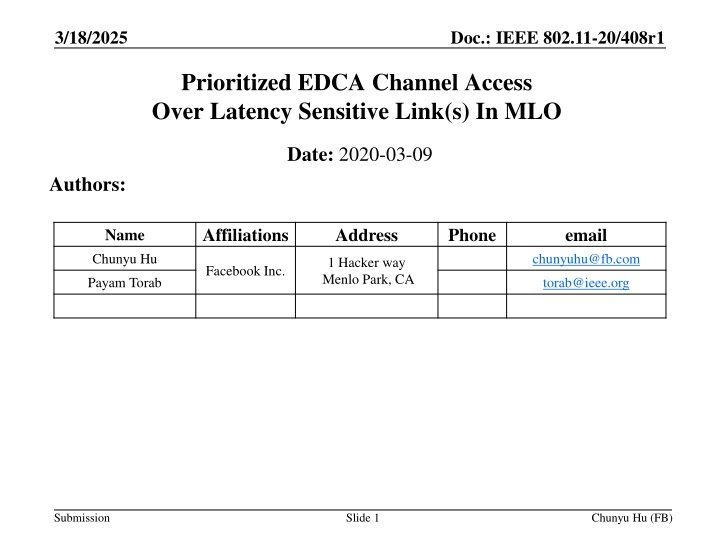
Improving Latency Performance in Multi-Link Operation: Key Design Features
Enhance latency performance by defining differentiated services over Multi-Link Operation (MLO) links, allocating subsets for latency-sensitive traffic, and implementing a prioritized EDCA channel access scheme. This project aims to improve WLAN latency and jitter requirements, supporting time-sensitive networks with efficient traffic steering and load balancing strategies.
Download Presentation

Please find below an Image/Link to download the presentation.
The content on the website is provided AS IS for your information and personal use only. It may not be sold, licensed, or shared on other websites without obtaining consent from the author. If you encounter any issues during the download, it is possible that the publisher has removed the file from their server.
You are allowed to download the files provided on this website for personal or commercial use, subject to the condition that they are used lawfully. All files are the property of their respective owners.
The content on the website is provided AS IS for your information and personal use only. It may not be sold, licensed, or shared on other websites without obtaining consent from the author.
E N D
Presentation Transcript
3/18/2025 Doc.: IEEE 802.11-20/408r1 Prioritized EDCA Channel Access Over Latency Sensitive Link(s) In MLO Date: 2020-03-09 Authors: Affiliations Address Phone email Name Chunyu Hu chunyuhu@fb.com 1 Hacker way Menlo Park, CA Facebook Inc. Payam Torab torab@ieee.org Submission Slide 1 Chunyu Hu (FB)
3/18/2025 Doc.: IEEE 802.11-20/408r1 Abstract Multi-link operation (MLO), a key 11be feature, enables flexible traffic steering and load balancing This presentation targets at improving latency performance with the following key design: 1. Define and provide differentiated services over MLO links, and specifically, allocating a subset of MLO links for latency sensitive traffic*, referred as Latency Sensitive Links 2. A prioritized EDCA channel access scheme over latency sensitive links * While the main traffic carried by the link is latency sensitive, there can be some portion of traffic for general purpose data transfer originated from the same device; it s also possible to allow regular traffic if there is excessive bandwidth available. Submission Slide 2 Chunyu Hu (FB)
3/18/2025 Doc.: IEEE 802.11-20/408r1 Background EHT aims at improving support for time sensitive networks This project will improve the latency and jitter of WLAN. [1] General requirements [2]: Intra-BSS latency in range < 10 ms (e.g. ~3-5ms for real-time video) Jitter variance < 2.5ms Packet loss: nearly lossless Bandwidth: 10s or 100s of Mbps, multi-Gbps for uncompressed cases MLO framework supports: Dynamic link enabling/disabling. Uni-directional TID-to-Link mapping Multi-link aggregation increase throughput Asynchronous/synchronous transmission increase channel access opportunity in presence of legacy/OBSS traffic Differentiated services overs different links More practical to do more for latency sensitive traffic yet service regular traffic as well Still some gap remains: support many latency sensitive traffic streams in the same BSS, and in multiple such BSS s Submission Slide 3 Chunyu Hu (FB)
3/18/2025 Doc.: IEEE 802.11-20/408r1 Traffic Characteristics (1) A latency sensitive traffic stream can be characterized by the following parameterized model: Packets arrive in a bursty fashion, with a periodic interval T T is a stable variable and can be considered constant over minutes or longer E.g. video display traffic is driven by the refresh/sync rate, 60/72/90/120 Hz, translating to 16.7/13.9/11.1/8.3 ms period (CBR / VBR) Amount of traffic within each interval is variable but has a stable average over seconds or longer Example: a VR rendering stream is characterized by the following parameters: Refreshing rate: 60/72/90/120 Hz Resolution: 4K 3840x2160 # of frames: one or more displays Bits/pixel: 24 bits/pixel Compression ratio (CR): decided by codec and content. with CR=100, 1 frame per interval, throughput ~ 120 Mbps Application (frame) Amount of traffic can vary from interval to interval T T time Submission Slide 4 Chunyu Hu (FB)
3/18/2025 Doc.: IEEE 802.11-20/408r1 Traffic Characteristics (2) A latency sensitive application/system can have combinations of such streams of different parameters. It can also contain other best effort data stream that are more spontaneous/aperiodic. It can also have some application level of control traffic Example: a VR device with hand controllers Use case 1: gaming Use case 2: virtual video conference Use case 3: virtual classroom Transfer data: video, voice, file Rendering data / misc Sensor/camera/ misc data See https://lilyotron.blog/2018/04/12/the-top-10-vr-apps-for-remote-workers/ for some fancy app Submission Slide 5 Chunyu Hu (FB)
3/18/2025 Doc.: IEEE 802.11-20/408r1 Network Topology For each stream of the application, the direction of traffic can be AP non-AP device (DL) Non-AP device AP (UL) Non-AP device tethered peer device that may or may not associate with the same AP (peer-to-peer) Also consider the case where two or more BSSs operate on the same channel as results of limited spectrum availability e.g. Device peer-to-peer Client3 Client 5 AP1 AP2 Client2 Client4 peer-to-peer Client1 peer-to-peer device device Submission Slide 6 Chunyu Hu (FB)
3/18/2025 Doc.: IEEE 802.11-20/408r1 Differentiated Services over Different Links in MLO MLO supports: Directional TID-to-Link mapping [3] Link enable/disable through negotiation/handshake [4] These enables various possible configurations. Configuration Example 1 Configuration Ex. 2 Configuration Ex. 3 5G channel AP MLD 2G channel Split traffic into two sets based on TIDs/ACs Submission Slide 7 Chunyu Hu (FB)
3/18/2025 Doc.: IEEE 802.11-20/408r1 Description of Configurations in Previous Page Configuration 1 (device based): Non-AP MLDs carrying latency sensitive traffic as major traffic operate over one or a subset of links Note: a MLD having latency sensitive traffic may also have some other associated data traffic Configuration 2 (TID based): Map one set of TIDs to one subset of links, and rest TIDs to other links. Configuration 3 (direction based): Some links are dedicated for UL using triggering; and rest links for other traffics. Submission Slide 8 Chunyu Hu (FB)
3/18/2025 Doc.: IEEE 802.11-20/408r1 Latency Sensitive Links Specifically, define an operating mode in MLO, where AP MLD, based on association and traffic dynamics, can steer latency sensitive traffic over a subset of links using any suitable configurations (separate contribution) Referred as Latency sensitive links Provide more predictable and prioritized medium access to the latency sensitive traffic or devices whose majority of traffic is latency sensitive (Guideline: light-weight scheduling, flexible enough to accommodate network and traffic dynamics, avoid losing peak throughput performance.) See NEXT Submission Slide 9 Chunyu Hu (FB)
3/18/2025 Doc.: IEEE 802.11-20/408r1 Prioritized EDCA Access to Time Slotted Channel 1. AP defines new set EDCA parameters in addition to default SU/MU EDCA parameters (referred as regular EDCA parameters): For latency sensitive traffic streams. Only admitted STAs can use them over designated time slots Prioritized EDCA access Over the link, time is divided into TBD-granularity time slots (e.g. 1TU, TU) per TBD-interval (e.g. BEACON). AP assigns the membership of one or multiple slots based on the handshake with STA and/or its scheduling of DL traffic. More details in next two slides. 2. Submission Slide 10 Chunyu Hu (FB)
3/18/2025 Doc.: IEEE 802.11-20/408r1 Details: Channel Access A slot can be assigned to one or more STAs for DL/UL/Peer transmissions For slots not assigned: All STAs operating over the link can contend the access using the regular EDCA parameters For slots assigned to one or more STAs (referred as owners): The owners access these slots using a second set of EDCA parameters to gain more deterministic and low latency (prioritized) access. Other STAs (not assigned to these slots) can still access the slots but use different access policy. For example (details to be further defined/discussed in next step): Option-1: using the regular EDCA parameters Option-2: using a third set of EDCA parameters/behavior in order to make sure the owner to gain enough priority. Other options: ? Advantages of non-exclusive access to slots: Traffic is hardly constant: it can vary over time even for the same stream. E.g. a video frame size can vary frame by frame after compression. Unused time in slots is still open for non-owners to access not wasting bandwidth. Less stringent requirement on the scheduling algorithm. Submission Slide 11 Chunyu Hu (FB)
3/18/2025 Doc.: IEEE 802.11-20/408r1 Details: Management of Time Slots AP accepts non-AP MLD s request in form of 1) direct assignment of slots; and/or 2) traffic requirement, and assign one or more contiguous/non-contiguous slots AP may take into account of STA s capability to decide if performing DL/UL MU transmission and decide if grouping a few STAs/slots together Non-AP MLD can request slots for the communication between itself and other peer (MLD) devices AP can assign slots for traffic originated from AP itself However, for some application running on a device, the client device may know the traffic characteristic better afore-head. The requesters/owners of the slots should monitor their traffic dynamics and update the reservation as needed. AP monitors the utilization of slots, and may force release or change assignments AP broadcasts this information in form of bitmap to share across intra-/inter-BSS STAs Help distribute contention among the set of STAs with latency sensitive traffic Allow APs of different BSS s to coordinate Coordinated AP scheme (to be defined, ) Submission Slide 12 Chunyu Hu (FB)
3/18/2025 Doc.: IEEE 802.11-20/408r1 What It Does and What It Does NOT Prioritize: provides STAs requiring more stringent latency a higher probability of QoS delivery without hurting network performance in absence of such STAs Distribute: it tries to distribute access among STAs of higher priority to different time slots to avoid contention among themselves Increase capacity for a network containing many latency sensitive devices Enabling peer-to-peer traffic to gain prioritized access as well Can do so without much involvement of AP at packet/txop level (AP doesn t know peer-2-peer traffic info anyways!) Coordinate: scalable and light-weighted scheduling intra-BSS and can be extended to support multi-BSS coordination It does NOT define a scheduling algorithm for applications Each device/application have to characterize their traffic patterns at their best knowledge or via prediction and come up with intended slots to sign up. This can include their own originated traffic, the traffic to be received, or peer-to-peer communications. Submission Slide 13 Chunyu Hu (FB)
3/18/2025 Doc.: IEEE 802.11-20/408r1 More Discussion The proposed prioritized EDCA access can be supported without MLO But MLO has more flexibility and provides more benefits The scheme can be a key component leading to a multi- AP coordination scheme in 11be. More details to be hashed out in protocol design Such as but not limited to: Interval/slot, EDCA parameter/access policy in assigned slots; admission control in this framework; multi- AP coordination of slot allocation Submission Slide 14 Chunyu Hu (FB)
3/18/2025 Doc.: IEEE 802.11-20/408r1 References [1] 11-18-1233-07-0eht-eht-draft-proposed-csd [2] 11-18-2009-06-0rta-rta-report-draft.docx [3] 11-19-1924-01-00be-multilink-steps-for-using-a-link.pptx [4] 11-19-1904-03-00be-mlo-link-management-follow-up.pptx Submission Slide 15 Chunyu Hu (FB)
3/18/2025 Doc.: IEEE 802.11-20/408r1 Straw Poll 1 Support differentiated quality of services over different links in Multi-link Operation Submission Slide 16 Chunyu Hu (FB)
3/18/2025 Doc.: IEEE 802.11-20/408r1 Straw Poll 2 Defines a mechanism of prioritized EDCA access to time-slotted channel Submission Slide 17 Chunyu Hu (FB)
3/18/2025 Doc.: IEEE 802.11-20/408r1 Straw Poll 3 Defined Latency Sensitive Links in Multi-Link Operation as one or more links over which a prioritized EDCA access over time-slotted channel is defined and conducted by STAs to provide differentiated quality of service. Submission Slide 18 Chunyu Hu (FB)
3/18/2025 Doc.: IEEE 802.11-20/408r1 Straw Poll 4 Define a procedure to share and coordinate time resource allocation for prioritized EDCA access in multiple BSS operation over partially or fully overlapping channels. Submission Slide 19 Chunyu Hu (FB)
3/18/2025 Doc.: IEEE 802.11-20/408r1 APPENDIX Submission Slide 20 Chunyu Hu (FB)
3/18/2025 Doc.: IEEE 802.11-20/408r1 Feasibility of Providing Differentiated QoS over Different Links in a BSS A lot of existing AP already have multi-band capability It s natural to assume most APs capable of 11be will be able to support multiple links as well (even some STAs don t) With MLO, it s possible to divide links on-demand into two groups: one for latency sensitive traffic or devices carrying such traffic, and the other for rest AP can monitor CCA over channels and choose one or more clean channels allocated as latency sensitive link(s) MBO/OCE certificate program in WFA 6 GHz makes more channels and channel of bigger bandwidth available once regulatory release for unlicensed usage Green-field for 11ax and 11be Submission Slide 21 Chunyu Hu (FB)
3/18/2025 Doc.: IEEE 802.11-20/408r1 Example 1: Network with Latency Sensitive App/Device joining A MLO network with two links: two regular* clients. One client operates at link 1 (client A) and the other client operates at link 2 (client B). 1) A third device (client B) associates, carrying latency sensitive traffic. It is steered to link 2 and through negotiation handshake, obtained two slots for prioritized EDCA access. 2) Client B can be still present but with reduced throughput as result of shared bandwidth. 3) Six more devices with latency sensitive traffic joined and are allocated slots to have distributed/prioritized EDCA access. Client B can still operate in link 2 but with further reduced throughput. It can choose to stay on link 2 but AP hasn t forced it to do so. 4) When the 8-th device joining link-2 with latency sensitive traffic, AP decides the link capacity is about to saturate. It hence steers client B to link-1. *: STAs that doesn t register a device with any latency sensitive traffic. Submission Slide 22 Chunyu Hu (FB)
3/18/2025 Doc.: IEEE 802.11-20/408r1 Example 2: Coexistence With Legacy STAs Over latency sensitive links, it is still possible that a legacy STA can be still admitted/operating in coexistence with STAs that understand the prioritized EDCA access protocol. A legacy STA doesn t have time slot view, and it operates with default (regular) EDCA parameters. Owners of designated slots have more aggressive EDCA parameters and hence still have higher priority to gain more immediate channel access Not ideal, but still an improvement compared to without this new protocol. Mitigation mechanism can be invoked by AP via, e.g. UL MU scheduling; admit or steer legacy STAs over non-latency sensitive links (MBO/OCE). Submission Slide 23 Chunyu Hu (FB)
3/18/2025 Doc.: IEEE 802.11-20/408r1 Compared to TWT TWT doesn t provide any special medium access method It doesn t have any restrictions on use of medium for non-TWT participants, either TWT doesn t advertise all STA s start/end/period in the way the proposed mechanism enables Scalability Coordination TWT involves more overhead in negotiating/settling with STA on a schedule (demand/reject/suggest/accept). To satisfy traffic requirement, STA may have to sign up multiple TWT sessions. More challenging to track. In proposed mechanism, a STA can sign up multiple groups of slots in one request Submission Slide 24 Chunyu Hu (FB)


